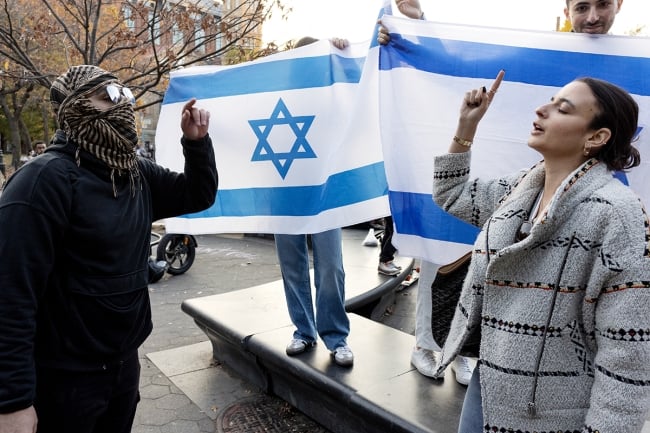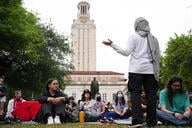You have /5 articles left.
Sign up for a free account or log in.

Supporters of Israel exchange insults with supporters of Palestine at a rally held by New York University students.
Andrew Lichtenstein/Corbis via Getty Images
A new report by Brandeis University says Jewish students’ perceptions of campus climate vary “dramatically” from institution to institution.
The report, released Thursday by the university’s Maurice and Marilyn Cohen Center for Modern Jewish Studies, is based on a survey of Jewish students at colleges and universities across the country and was designed to determine which campuses were “hot spots of antisemitism” since the start of the Israel-Hamas war.
Participants were asked about their views on the level of anti-Jewish and anti-Israel hostility on their campuses as well as their overall degree of concern about antisemitism. Each institution was then assigned a quartile ranking based on the results.
As many as 83 percent of students at institutions in the top quartile for hostility reported some or much concern about antisemitism, compared to relatively few—55 percent—students in the lowest quartile.
The survey sampled about 2,000 undergraduate students who had applied to participate in Birthright Israel, a heritage trip to Jerusalem for young adults of Jewish background. The respondents’ levels of religious and/or cultural education in primary and secondary school varied, and so did their opinions of the Israeli government. The sample population also spanned 51 colleges and universities of diverse size, location, selectivity and estimated Jewish population.
(The report notes that some colleges had more respondents than others and that students who have experienced antisemitism may have been more likely to respond.)
Ken Stern, director of the Bard Center for the Study of Hate, voiced concern about the limitations of the survey and the students’ ties to Birthright Israel.
“This isn’t representative of all Jewish students,” he said.
Reports of antisemitism on college campuses and tensions on campuses related to the Israel-Hamas war have been a topic of heated discussion across the country since the conflict broke out in Israel on Oct. 7. Many college leaders have been widely criticized for their responses to Jewish students’ complaints of antisemitic incidents and hostility toward them on campuses. However, efforts to track students’ perceptions of antisemitism on campuses have been relatively limited. The Anti-Defamation League released findings from a similar survey in November.
In addition to bolstering the volume of existing data on college antisemitism, Leonard Saxe, a professor of contemporary Jewish studies at Brandeis and co-author of the report, said he hopes the findings broaden the scope of campus climate coverage by national media. So far, public attention has mostly focused on elite private universities in the Northeast.
“The universities that had been in the headlines … are not necessarily representative of what’s going on across the board,” Saxe said.
He noted that at some colleges, such as Tulane University in New Orleans, there have been serious incidents of antisemitism and even assaults on Jewish students at protests, yet survey results show that Tulane students perceive the institution as one with a comparatively low level of hostility.
“If you read newspapers, you would think that every single campus in the country is on fire,” he said. “But there are some campuses, even campuses that had serious incidents, where students don’t feel the level of harassment and being targeted that they do at other campuses.”
“We think that that tells us that there may be things that campuses can do to address the problem,” Saxe added.
Variations and Commonalities
Julia Jassey, CEO and co-founder of Jewish on Campus—a student-driven national organization, believes the data will be validating for many students.
“It seems quite in line with the stories that we’re hearing and with the experiences that are being highlighted,” Jassey said. “While the antisemitic hostility is varying, the experience overwhelmingly among students across various campuses is that antisemitism is a real and growing problem.”
She added that the most commonly perceived occurrences of antisemitism are no longer those of traditional tropes about the Jewish community but are in the context of the war and critiques of Israel as a nation. Across all four categories of institutions, from those with the highest to lowest levels of overall antisemitism, at least 63 percent of students reported a sense of anti-Israel hostility on campus, compared to at least 49 percent who agreed there was hostility against Jews.
And survey data showed that concerns about anti-Israel hostility were not limited to Jewish students who had self-declared favorable views of the Israeli government. Among the 44 percent of respondents who had unfavorable views of the Israeli government, 45 percent were very concerned about antisemitism related to criticism of Israel.
Other trends include students at institutions in all four categories expressing more concern about hostility emanating from people on the political left than the right and reporting incidents involving peers more than faculty and administrators. Jassey believes knowledge of such trends will better equip university leaders to respond.
“It both highlights the variation between different campuses … but also shows that a lot of these trends are overarching across lots of campuses,” she said.
Part of a Wider Phenomenon
The report also notes that antisemitism is “far more prevalent” now than it was in 2016, when Brandeis conducted a similar study.
Pamela Nadell, director of the Jewish studies program at American University, said her research confirms similar trends, and she noted events such as a physically combative 2018 rally involving pro-Israel and pro-Palestinian students at New York University or when the Williams College student government declined official recognition of a newly formed pro-Israel student group in 2019.
“We can’t look at what is happening on the college campus without understanding that it’s part of a wider phenomenon in the United States,” said Nadell, who testified at the Dec. 5 congressional hearing about college leaders’ responses to antisemitism. “If we needed more evidence to prove that, we would just look at the fact that in May 2023, the White House issued the National Strategy to Combat Antisemitism.”
Alyza Lewin, president of the Louis D. Brandeis Center for Human Rights Under Law, a Jewish civil rights group, worries that the variations in rankings across campuses may give some college administrators the false impression that antisemitism is not a growing problem on their campus.
“It would behoove all university administrators to realize that anti-Semitism is spreading like wildfire across campuses in the US,” Lewin said in an email.
Other Students Overlooked
Corey Saylor, research and advocacy director at the Council on American-Islamic Relations, said there is little, if any, parallel research or comparable tracking of incidents of Islamophobia on college campuses. Saylor said that although it is a topic of interest at his organization and likely many others, it’s a project CAIR doesn’t have the bandwidth to complete.
“My department handles both research and individual advocacy cases,” he said. “My team’s monthly caseload went up 678 percent” in October and November, compared to earlier this year.
However, Saylor said that anecdotally he’s hearing a general trend that students who participate in rallies and protests “on behalf of Palestinian humanity” feel unprotected by campus administration and are concerned about being doxed, or having their personal information revealed online, and targeted.
He believes the public narrative about antisemitism on college campuses is pushing university administrators to prioritize addressing antisemitism over other forms of bias.
“Antisemitism needs to be dealt with. It’s atrocious,” Saylor said. “But that reality does not lessen the atrociousness of other forms of bias, such as anti-Arab bigotry or Islamophobia.”




